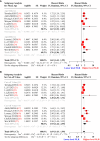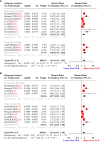Predictive value of the neutrophil-to-lymphocyte ratio in the prognosis and risk of death for adult sepsis patients: a meta-analysis
- PMID: 38562922
- PMCID: PMC10982325
- DOI: 10.3389/fimmu.2024.1336456
Predictive value of the neutrophil-to-lymphocyte ratio in the prognosis and risk of death for adult sepsis patients: a meta-analysis
Abstract
Background: The neutrophil-to-lymphocyte ratio (NLR) is a commonly used biomarker for acute inflammation that often rises during sepsis, making it a valuable diagnostic indicator for clinical practice. However, no consensus has been reached on the prognostic value of NLR for predicting the prognosis and mortality risk in adult sepsis patients. In light of this controversy, we conducted a meta-analysis to clarify the prognostic significance of NLR in adult sepsis patients. The meta-analysis was registered in the PROSPERO database (registration number CRD42023433143).
Methods: We performed a comprehensive literature search in PubMed, Cochrane Library, Ovid, and Springer databases, using retrieval terms "sepsis" or "septic shock" and "prognosis" or "mortality" for studies published between January 1, 2000, and May 31, 2023. Children and neonates with sepsis were excluded from our research. Two independent researchers conducted the literature search and data extraction. Consensus was reached when discrepancies occurred, and in case of persistent discrepancies, the final decision was made by the research supervisor. The hazard ratio (HR) and its corresponding 95% confidence interval (95% CI) were extracted from each study included in the analysis. A random-effects model was used to synthesize all HRs and their 95% CIs. Sensitivity analysis was performed to investigate heterogeneity. Sensitivity analysis was conducted to identify studies that had a significant impact on the overall results of the meta-analysis. Subgroup analysis and meta-regression were performed to explore sources of heterogeneity. Egger's test was also used to investigate publication bias in this meta-analysis.
Results: After a comprehensive literature search and screening, we included 12 studies comprising 10,811 patients for the meta-analysis. The pooled results indicated that patients with a higher NLR level were associated with a poor prognosis (Random-effects model, HR: 1.6273, 95% CI: 1.3951-1.8981). Heterogeneity testing showed significant heterogeneity (I2 = 87.2%, 95% CI: 79.5-92, p<0.0001). Sensitivity analysis was performed to investigate the sources of heterogeneity, which revealed that the omission of one highly sensitive study significantly reduced the I2 value. After removing this study, a strong association was found between a higher NLR level and poor prognosis and risk of death in adult sepsis patients (Random-effects model, HR: 1.6884, 95% CI: 1.4338-1.9882). Both subgroup analysis and meta-regression indicated that the study design and testing time of NLR were sources of heterogeneity. Egger's test showed no obvious publication bias in this meta-analysis.
Conclusion: NLR is a reliable and valuable biomarker for predicting prognosis and the risk of death in adult sepsis patients.
Systematic review registration: [https://www.crd.york.ac.uk/prospero/display_record.php?ID=CRD42023433143] PROSPERO, identifier [CRD42023433143].
Keywords: NLR; adult sepsis; meta-analysis; mortality; prognosis.
Copyright © 2024 Wu, Cao, Ji, Luo, Huang and Ma.
Conflict of interest statement
The authors declare that the research was conducted in the absence of any commercial or financial relationships that could be construed as a potential conflict of interest.
Figures







References
Publication types
MeSH terms
Substances
LinkOut - more resources
Full Text Sources
Medical

